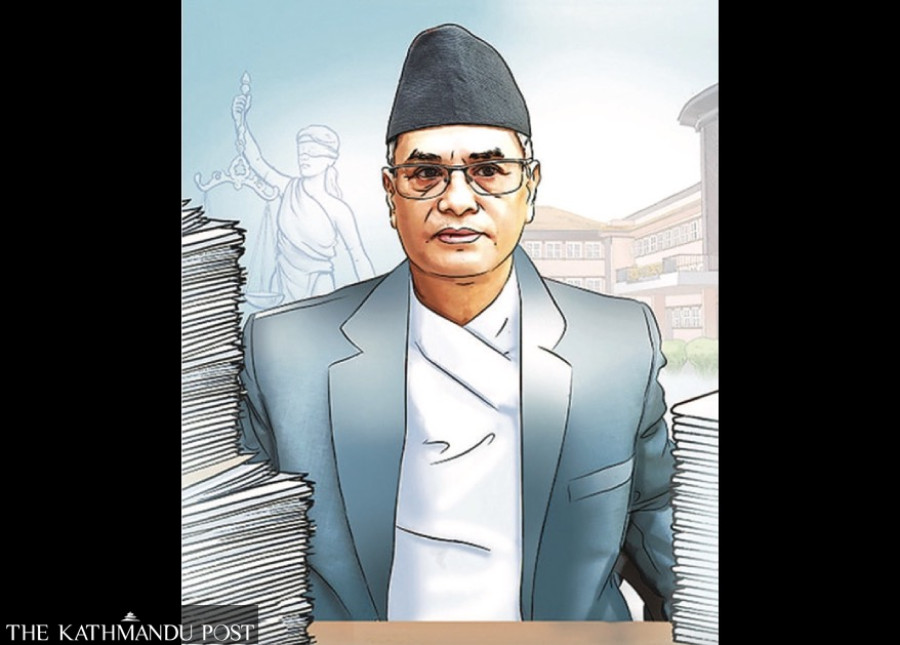National
With Chief Justice Rana refusing to budge, observers call ongoing protests misplaced
Experts suggest protests should focus on pressuring political parties for impeachment.
Binod Ghimire
Among the seven conditions mentioned in the Constitution of Nepal for vacating the post of chief justice, two are applicable for Chief Justice Cholendra Shumsher Rana at present. The first is his resignation and the second, his impeachment by parliament.
Supreme Court justices and the legal fraternity are continuously demanding Rana’s resignation. Their pressure tactics—from boycotting the benches to barring the chief justice from entering his office—have so far remained fruitless. As per the constitution, resignation is Rana’s prerogative and he has proved this by refusing to resign.
The second option—impeachment—is the prerogative of parliament. Rana has been saying he won’t resign and challenging his opponents to remove him through the constitutional way, which is impeachment. However, the protest is rather focused on piling pressure on Rana to resign than pushing the parties to take the constitutional course to remove him.
“The lawyers are protesting at the wrong place barring the general public from access to justice,” Shree Krishna Aniruddh Gautam, a columnist with the Post’s sister paper Kantipur, told the Post. “Their protest should have focussed on pressuring the political parties for an impeachment motion, which is the constitutional way to remove Rana.” Though the agitating lawyers have been urging the political parties to start an impeachment process they haven’t announced any activities to pressure the parties.
Observers say the lawyers involved in the agitation are affiliated to one or another of the political parties and they can lobby the leaderships of the respective parties for impeachment. But unlike the stern measure they are applying on the Supreme Court, they have done little to pressure the parties.
Gautam said had the lawyers taken the right course they could have achieved their goal by causing less harm to the judiciary. As per Article 101 (2) of the Constitution of Nepal, a quarter members of the House of Representatives can register an impeachment motion against Rana which will lead to his automatic suspension until it is decided. The ruling parties have strength to register a motion but it cannot be ratified without the support of the main opposition, the CPN-UML.
The prolonged protest is obstructing the justice delivery process and tarnishing the image of the judiciary.
The justices, starting October 25, boycotted the benches demanding Rana’s resignation. As he refused to resign they are facing moral pressure to resume case hearings. Rejoining the benches without Rana’s resignation signals their defeat while further continuation of the protest would be against their constitutional duties.
The Supreme Court already has over 24,756 cases from the previous year and the justices could have settled over 2,000 cases if they had not resorted to protest since October 25. Hearings of even habeas corpus petitions have been affected while not a single petition has been registered in the court for the last three weeks now.
“We thought Rana would resign if Nepal Bar Association demanded. But he refused. How long can we afford to keep the judiciary hostage,” Rudra Pokharel, a treasurer of the Nepal Bar Association, told the Post. “I agree that obstructing the work of the Supreme Court is wrong. We should have trained our focus towards pressurising the political parties.”
Pokharel said the prolonged protest has only taken its toll on the image and reputation of the judiciary, consequently weakening it. The Bar Association has announced the protest till Tuesday and its future course will be determined evaluating the ongoing protests on Wednesday. Pokharel said he will raise the issue of misplaced protest at the upcoming meeting.
Meanwhile, the protesting lawyers say they had not thought Rana would be able to withstand the pressure from the entire legal fraternity that wants him to quit. They agree that the protests should have been targeted at the political parties also. “It is already late to adopt a multi-pronged strategy. Demonstrations at the Supreme Court alone are not going to work,” senior advocate Dinesh Tripathi, chairperson of the Constitutional Lawyers’ Forum, told the Post. “We cannot be indifferent to the service seekers for long just because Rana is irresponsible and immoral.”
Tripathi said he still believes that parties will speak up soon and Rana will resign. He, however, says if that does not happen, it might be necessary for them to resume case hearings by selectively boycotting the benches attended by Rana. Observers say the ongoing crisis in the Supreme Court must be resolved before people start losing their faith in the judiciary.
Issuing a statement, four former university vice-chancellors including Kedar Bhakta Mathema and Kamal Krishna Joshi on Saturday said it is the political parties and the government who should be taking a lead to resolve the ongoing crisis. “Where will people go for justice if they lose faith in the judiciary,” they said in the statement. “It is already late to resolve the ongoing crisis.”
Bar officials agree that not just Rana but all the justices and even the lawyers will have to take the blame if the Supreme Court is paralysed due to their prolonged protest. “The prolonged protest means the weakened judiciary will be paralysed,” said Pokharel, the treasurer. “We cannot just blame Rana and escape. Everyone involved, including lawyers and justices, must be answerable.”




 5.55°C Kathmandu
5.55°C Kathmandu







%20(1).jpg&w=300&height=200)






